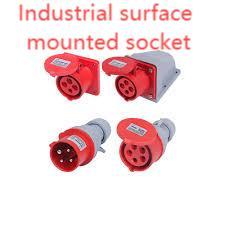In challenging industrial settings, the Industrial surface mounted socket serves as a critical interface, enabling secure and stable connections between heavy machinery and power sources without compromising safety or efficiency.
1. Evaluating Power Infrastructure Needs
Before selecting any socket solution, it’s essential to assess the facility’s power requirements. Consider the voltage and current ratings of connected equipment, as well as peak inrush currents that motors and drives may generate. Balance these electrical demands with future upgrade plans—oversizing a socket’s capacity by 20–30% can accommodate new machinery without requiring immediate rewiring. Additionally, map out the physical layout to determine optimal mounting locations that minimize cable runs and reduce tripping hazards.
2. Selecting Durable Materials
Industrial environments expose components to dust, moisture, chemicals, and mechanical impact. Choose sockets crafted from reinforced polymers or die-cast aluminum alloys for enhanced resilience. Polymer housings offer excellent resistance to corrosion and UV degradation, while metal bodies provide superior heat dissipation. Prioritize sockets with high ingress protection ratings (IP65 or above) and anti-vibration mounting features to prevent loosening over time. Sealed gaskets and stainless-steel fixings further ensure long-term durability in washdown or chemical-processing areas.
3. Schneider Electric Integration
Schneider Electric’s range of surface-mounted sockets exemplifies how modular design meets industrial needs. Their systems feature snap-on accessory modules—such as surge protectors and RCDs—that fit directly onto the socket housing without extra enclosures. Integrated LED indicators alert technicians to power status, and tool-free locking mechanisms allow for quick field replacement. By combining power outlets with intelligent monitoring, these solutions support predictive maintenance initiatives and reduce unplanned downtime on the plant floor.
4. Installation Best Practices
Proper installation is key to socket longevity and performance. Begin by choosing a flat, stable mounting surface that can bear the socket’s weight and cable stress. Drill precise openings for conduit entries, then use torque-controlled drivers to secure fixings according to manufacturer specifications—too much force can crack housings, while too little risks water ingress. Ensure correct grounding by tightening the earth terminal with a calibrated torque wrench. Label each socket clearly to correspond with electrical schematics, aiding future troubleshooting and compliance audits.
5. Proactive Maintenance Strategies
Routine inspections and servicing extend socket lifespan and maintain safety standards. Schedule visual checks every quarter to look for cracked housings, loose connections, or discoloration—early signs of wear or overheating. Clean contacts using non-conductive sprays, and apply a thin coating of dielectric grease to repel moisture. Replace gaskets and seals annually, even if they appear intact, to preserve ingress protection. Use a digital log to record maintenance actions and performance metrics, enabling trend analysis and informing timely socket upgrades.
By thoroughly evaluating electrical loads, choosing robust socket materials, integrating advanced modular systems, and adhering to meticulous installation and maintenance protocols, industrial operators can ensure reliable power distribution and minimize operational disruptions. Such diligence pays dividends in safety, efficiency, and total cost of ownership. www.nante.com

